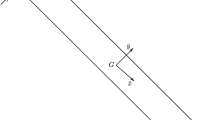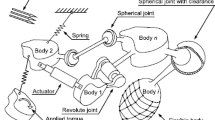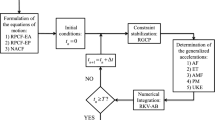Abstract
The modal characteristics of constrained multibody systems undergoing constant accelerated motions are investigated in this paper. Relative coordinates are employed to derive the equations of motion, which are generally nonlinear in terms of the coordinates. The dynamic equilibrium position of a constrained multibody system needs to be obtained from the nonlinear equations of motion, which are then linearized at the dynamic equilibrium position. The mass and the stiffness matrices for the modal analysis can be obtained from the linearized equations of motion. To verify the effectiveness and the accuracy of the proposed method, two numerical examples are solved and the results obtained by using the proposed method are compared with those obtained by analytical and other numerical methods. The proposed method is found to be accurate as well as effective in predicting the modal characteristics of constrained multibody systems undergoing constant accelerated motions.
Similar content being viewed by others

References
Bae, D. S. and Haug, E. J., 1987, “A Recursive Formulation for Constrained Mechanical System Dynamics: Part I. Open Loop Systems,”Mechanics of Structures and Machines, Vol. 15, No. 3, pp. 359–382.
Bae, D. S. and Haug, E. J., 1987, “A Recursive Formulation for Constrained Mechanical System Dynamics: Part II. Closed Loop Systems,”Mechanics of Structures and Machines, Vol. 15, No. 4, pp. 481–506.
FunctionBay Inc., 2002,RecurDyn User’s Manual Ver. 4.
Haug, E. J., Wehage, R. A. and Barman, N. C., 1982, “Dynamic Analysis and Design of Constrained Mechanical Systems,”ASME Journal of Mechanical Design, Vol. 104, pp. 778–784.
Kim, S. S. and Vanderploeg, M. J., 1986, “A General and Efficient Method for Dynamic Analysis of Mechanical Systems Using Velocity Transformations,”ASME Journal of Mechanisms, Transmissions and Automation in Design, Vol. 108, pp. 176–182.
LMSCADSI Inc., 2002,DADS User’s Manual.
Lynch, A. G. and Vanderploeg, M. J., 1995, “A Symbolic Formulation for Linearization of Multibody Equation of Motion,”ASME Journal of Mechanical Design, Vol. 117, pp. 441–445.
MSC. Software Corporation, 2003,ADAMS User’s Guide.
Nikravesh, P. E., 1988,Computer-Aided Analysis of Mechanical Systems, Prentice Hall, International Inc.
Nikravesh, P. E. and Srinivasan, M., 1985, “Generalized Coordinate Partitioning in Static Equilibrium Analysis of Large-Scale Mechanical Systems,”International Journal for Numerical Methods in Engineering, Vol. 21, pp. 451–464.
Orlandea, N., Chace, M. A., and Calahan, D. A., 1977, “A Sparsity-Oriented Approach to The Dynamic Analysis and Design of Mechanical Systems,”ASME Journal of Engineering for Industry, Vol. 99, pp. 773–784.
Paul, B., 1977, “Dynamic Analysis of Machinery via Program DYMAC,”SAE Paper 770049, Warrendale, PA.
Rosenberg, R. M., 1977,Analytical Dynamics of Discrete Systems, Plenum Press.
Sheth, P. N. and Uicker Jr.,J. J., 1972, “IMP (Integrated Mechanisms Program): A Computer Aided Design Analysis System for Mechanisms and Linkages,”ASME Journal of Engineering for Industry, Vol. 94, pp. 454–464.
Sohoni, V. N. and Whitesell, J., 1986, “Automatic Linearization of Constrained Dynamical Models,”ASME Journal of Mechanisms, Transmissions, and Automation in Design, Vol. 108, pp. 300–304.
Wehage, R. A. and Haug, E. J., 1982, “Generalized Coordinate Partitioning for Dimension Reduction in Analysis of Constrained Dynamic Systems,”ASME Journal of Mechanical Design, Vol. 104, No. 1, pp. 247–255.
Author information
Authors and Affiliations
Corresponding author
Rights and permissions
About this article
Cite this article
Choi, D.H., Yoo, H.H. Modal analysis of constrained multibody systems undergoing constant accelerated motions. KSME International Journal 18, 1086–1093 (2004). https://doi.org/10.1007/BF02983283
Received:
Revised:
Published:
Issue Date:
DOI: https://doi.org/10.1007/BF02983283



